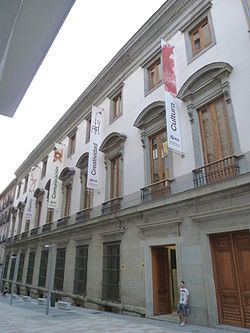Criteria Monument Reference no. RI-51-0004248 | Type Non-movable Designated 1977 | |
 | ||
Similar Palace of Bauer, Palacio de la Marques, Church of San Marcos, Palacio de Altamira, Basilica of Santa Maria - Ali | ||
The Palace of Altamira (Spanish: Palacio de Altamira), abbreviated Altamira Palace, is a palace located at number 8 Calle de la Flor Alta, near the Gran Via in Madrid, Spain. It was declared Bien de Interés Cultural (a national monument) in 1977. It was designed by the architect, Ventura Rodríguez, in 1772.
Contents
Location
The Palace of Altamira was a building of great magnitude, and which occupied an entire block, up to the Calle de San Bernardo (or Calle Ancha de San Bernardo as it was then called to distinguish it from the Calle Angosta de San Bernardo, know called Calle de la Aduana). This area was the axis around which the aristocratic residences of that time were grouped, until the next century when it was replaced by the Castellana. In addition to the aforementioned San Bernardo and Flor Alta, the palace had façades towards the Libreros and Marques de Leganes streets.
Construction
Construction did not begin until 1788, but at the celebrations of the coronation of Charles IV in September of the following year a representation of what the building would be like once work was completed was shown to him. On seeing the magnificence of what was presented he feared it could overshadow his own palace, also located at not too great a distance. This made him start to hinder its progress, with the result that, finally, from the original project only one of the bays was built, with a total area of 1344 square meters. Other versions say that these changes were simply of a financial nature.
The project included a monumental staircase, two courtyards, one with garden beds of French style, and a large oval floor chapel, all of which failed to materialize.
Remodelling
In 1887 the architect Mariano Belmas directed works that were undertaken to aesthetically standardize the building, especially an important part of the façade which had been left unfinished. the interior was already compartmentalized to accommodate office use by the twentieth century until they were later closed, remaining that way for over a decade, severely deteriorated. Finally, after acomplex rehabilitation, directed by Gabriel Allende Gil de Viedma, it has been housing, since October 2005, the seat of the Istituto Europeo di Design.
Proprietor
A famous owner of this palace was Vicente Osorio de Moscoso y Ponce de Leon. He was Grande of Spain, Duke of Sessa and Montemar, Marquis of Astorga, Leganes, Ayamonte and San Román, Count of Cabra and Altamira, Viscount of Iznajar, among others. He kept his large collection of paintings in the palace, one of the first in Spain.
Moscoso y Ponce de Leon's will, made on August 7, 1861, reflects the works of art that he owned. He left several paintings by Goya (now in the Royal Palace of Madrid), Federico Madrazo and several others to Queen Elizabeth II, cousin of the wife of his eldest son, Jose Maria Osorio Moscoso y Carvajal, the Infanta Luisa Teresa de Borbón y Borbón Dos Sicilias (daughter of Infante Francisco de Paula de Borbón). In his will is found the large collections he had of Goya, Ruben, Velazquez, the Neapolitan Andrea Vaccaro and the portrait of Gonzalo Fernández de Córdoba, the Great Captain, owned by the Casa de Cabra.
